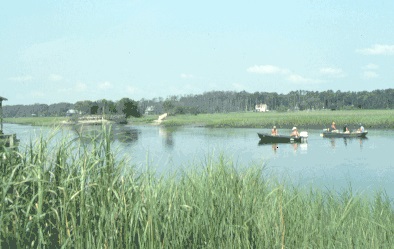Characterization of the Ashepoo-Combahee-Edisto (ACE) Basin, South Carolina
Recreational Fisheries
Recreational fishing in freshwater and saltwater is an activity that attracts people without regard to race, sex, or income level and can often influence the economy of an area (Hammond and Cupka 1977; Smith and Moore 1981). A variety of fishing opportunities exist in the ACE Basin study area, in habitats that range from black water streams and swamps to intertidal marshes, creeks and the ocean surf (Beasley et al. 1996).

Marine and freshwater recreational fishery resources of the Basin have become very important to the economics and aesthetics of the area. Most of the fishing activity is centered in the Edisto, Ashepoo, and Combahee Rivers, but other small streams in the watershed do provide some opportunities, especially for bank anglers. Most recreational fishing is done from small boats, but bank anglers use areas around landings and bridges. Because of the remoteness of the area, travel upstream in the rivers is often difficult due to obstruction by fallen trees. In general, directed fishing for specific species is done by boating anglers, while undirected fishing is done by bank anglers who catch what they can and keep most everything. Fishing licenses must be obtained to fish from a boat, but bank fishing does not require a license.
Estuarine waters in the ACE Basin study area are considered to be among the best inshore saltwater fishing locations in the state. Inshore anglers may fish in the surf of the front beaches of the barrier islands as well as from bridges, piers, and boats throughout the many rivers and tidal creeks in the ACE Basin study area and St. Helena Sound. Shore-based fishermen catch a variety of species in the marine section of the ACE Basin study area, including spot, Atlantic croaker, bluefish, summer and southern flounders, spotted seatrout, red drum, black drum, pinfish, southern and gulf kingfish, and sheepshead. White and brown shrimp are the species most sought by recreational shrimpers, as well as several different types of small sharks and rays. The blue crab is the only recreationally caught crab. Though not targeted, silver perch are also frequently caught.
High levels of exploitation by fishermen coupled with the loss of productive habitat due to coastal development and pollution have a major impact on estuarine recreational finfish stocks. For some species such as red drum, a gradual reduction in the recreational harvest has been implemented by measures such as size limits and bag limits. Assessments are regularly done to determine if such measures result in reduced mortality of highly sought recreational species throughout the region.
Recreational freshwater fisheries in the ACE Basin study area was valued at almost $2 million annually (Allen and Thomason 1993; Thomason et al. 1993). From the free-flowing streams to the tidally influenced sections of freshwater rivers and creeks, anglers target flathead catfish, largemouth bass, striped bass, redbreast sunfish, and black crappie. In addition, several species of sunfish and catfish are often caught, but not directly targeted.
The majority of freshwater angling is done from small to medium size boats (3.0-4.6 meters or 10-17 feet). Freshwater anglers are required to have a South Carolina fishing license to fish in public waters. The following issues are currently influencing the management of freshwater fisheries in the ACE Basin: (1) logging, (2) urban and industrial development, (3) introduction of foreign fish and plant species, (4) water withdrawal, (5) alteration to wetland habitat, (6) increases in nonpoint source pollution, and (7) instream integrity. The future looks bright for the ACE Basin freshwater fisheries resources. Educational efforts to inform citizens of the importance of natural resource protection are increasing. Because of efforts by government to encourage Best Management Practices (BMPs) and monitor industrial pollution, water quality is not deteriorating drastically. Wetlands are being preserved at an increased rate so that habitats vital for fish production will remain an integral part of the ACE Basin landscape.
